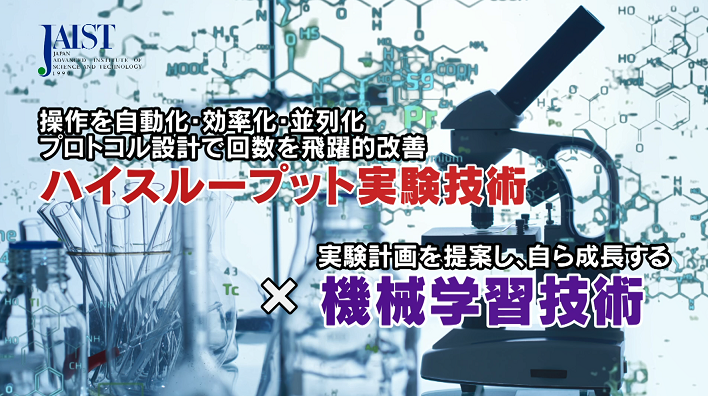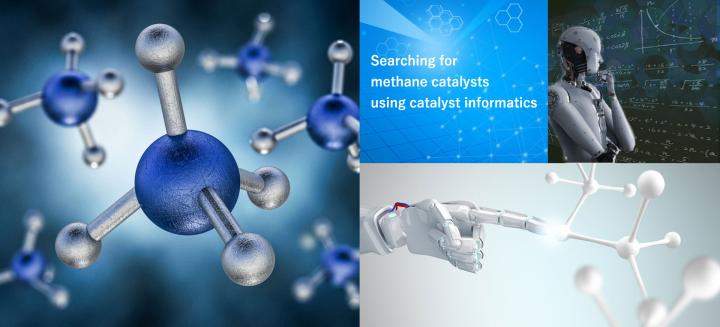Taniike laboratory aims to implement novel materials science based on "exploration" by high-throughput experiments, "learning" by data science, and "prediction" based on high-precision molecular modeling.
Exploration:
Combination of different elements and materials can bear an astronomical number of possibilities. One of the purposes in materials science is to discover good combinations and a novel way (process) to produce the combinations. We perform high-throughput experimentation using highly automated and/or parallelized instruments. We maximize the throughput of the experiments and change the research style from labor-intensive to brain-intensive works.
Learning:
High-throughput experimentation generates materials big data which include synthetic conditions, structural characteristics and performances of the materials. In order to implement efficient exploration of materials, it is not enough only to pick up good ones: It is necessary to clarify a structure-property relationship. Based on approaches of data science and materials informatics, we extract knowledge from the data and further accelerate materials discoveries.
Prediction:
Developments of computers and computational chemistry have enabled realistic simulation of complicated materials. Nonetheless, virtual materials design in computers (i.e. in-silico design) is still far to be practical. The most difficult task is how to obtain a molecular model which represents a material. We use experiments and simulations in a comprehensive fashion for establishing a high-precision molecular model towards in-silico materials design. Computational chemistry based on deep understanding of experimental materials science is aimed.
With the above three concepts, we pursue the following targets.
- Establish a methodology to efficiently discover breakthrough.
- Propose a rational solution to a social issue from a wide range of materials rather than focusing on a specific material.
- Cultivate materials scientists who can design an approach and methodology for a given subject with a broad view.
- Develop a capability of self-learning, examination, and strategy-planning.
Research Topics
Catalyst Informatics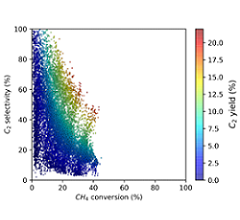
Since catalytic functions of materials are hard to predict, catalyst research has heavily relied on trials and errors with the aid of intuition and experience of individual researchers. We are promoting catalyst informatics on the basis of big data acquired by high-throughput experimentation in order to achieve the following issues:
- Rapid discoveries of promising catalysts without prior knowledge
- Extraction of catalyst design guidelines through the exploration of a vast materials space
- Elucidation of catalytic mechanism based on data-driven approaches
- Bringing breakthroughs to difficult catalytic reactions
Data-driven research premises the existence of a dataset sufficient in size, distribution, and consistency. However, such datasets are hardly available for catalysis. We have developed instruments and protocols for high-throughput experimentation, and thereby have accumulated catalyst big data necessary to realize catalyst informatics at an unprecedented scale and speed. Analysis of such data makes it possible to predict the performance of unknown catalysts and to extract catalyst design guidelines without relying on intuition or experience. Besides, the catalytic mechanism is uncovered in a data-driven manner through data-assimilated microkinetic simulation. Currently targeted reactions are chemical conversion of methane (oxidative coupling, direct methanol synthesis, reforming), exhaust gas purification, and photocatalytic water purification.
Literature: i) ACS Catal. 2021, 11, 1797; ii) ACS Catal. 2020, 10, 921; iii) https://www.alphagalileo.org/Item-Display/ItemId/204086; iv) ChemCatChem 2019, 11, 1146 ; v) Appl. Catal. A: Gen. 2020, 595, 117508; vi) https://www.youtube.com/watch?v=j_0SrPVzd3Y.
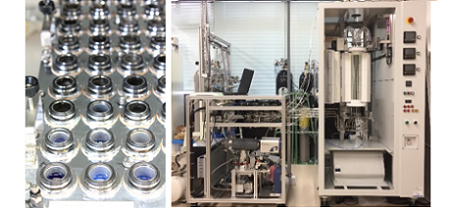 We develop instruments for high-throughput experimentation. These original instruments can produce high-quality data in a super efficient manner.
We develop instruments for high-throughput experimentation. These original instruments can produce high-quality data in a super efficient manner. Catalyst big data acquired by high-throughput experimentation. We demonstrated the acquisition of 13000 data in 3 days, which is one order of magnitude greater than literature data for 30 years.
Catalyst big data acquired by high-throughput experimentation. We demonstrated the acquisition of 13000 data in 3 days, which is one order of magnitude greater than literature data for 30 years.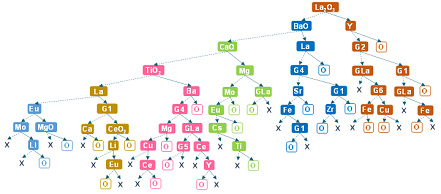 Catalyst design guidelines were obtained from data of randomly generated catalysts via machine learning. Materials design without prior knowledge will be soon realized.
Catalyst design guidelines were obtained from data of randomly generated catalysts via machine learning. Materials design without prior knowledge will be soon realized.Catalyst Structure-Performance Relationship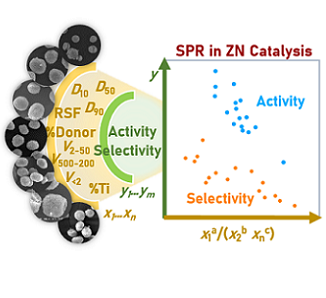
One advantage of solid catalysts over molecular catalysts is at the flexibility of design for multi-functionality. Integration of multiple components on a solid surface, and design of hierarchical morphology for achieving both the molecular sieving effect (selectivity) and the substrate diffusion (activity) are typical examples of strategies unique to the design of solid catalysts. In other words, the multifunctionality of catalysts is essential for simultaneously satisfying various constraints of chemical processes, but this entails increased complexity in the chemical composition and morphology of catalysts. This represents a part of attractiveness and difficulty in researching solid catalysts. If we could estimate a desired complex structure, we would be able to obtain an excellent multifunctional solid catalyst. However, the complexity itself hampers understanding of a relationship between the structure and performance, which is why trials and errors still play an important role in this field.
Our laboratory studies the structure-performance relationship (SPR) of solid catalysts to understand the origin of their multifunctionality. In particular, the SPR of the Ziegler-Natta catalyst as one of the most multifunctional solid catalysts is pursued by using a variety of approaches: high-precision molecular modeling by computational chemistry, multivariate analysis for SPR, and determination of catalyst nanostructures by machine learning and total X-ray scattering.
Literature: i) J. Catal. 2014, 311, 33; ii) J. Catal. 2012, 293, 39; iii) ACS Catal. 2019, 9, 2599; iv) J. Catal. 2020, 385, 76; v) J. Catal. 2020, 389, 525.
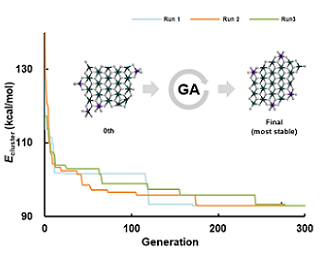 Advances in computers and density functional theory have realized accurate simulations of materials. On the other hand, an empirical aspect of creating a molecular model as an input forms a bottleneck of the research where a material is too complicated to deduce its structure, as in the case of solid catalysts. Our laboratory has developed a program that automatically determines catalyst nanostructures in a non-empirical fashion by combining the genetic algorithm and density functional theory. We study the significance of nanoscale heterogeneity in catalysis.
Advances in computers and density functional theory have realized accurate simulations of materials. On the other hand, an empirical aspect of creating a molecular model as an input forms a bottleneck of the research where a material is too complicated to deduce its structure, as in the case of solid catalysts. Our laboratory has developed a program that automatically determines catalyst nanostructures in a non-empirical fashion by combining the genetic algorithm and density functional theory. We study the significance of nanoscale heterogeneity in catalysis. A multifunctional catalyst is structurally complicated, and its performance is determined by a complex interplay of various structural factors. We study the structure-performance relationship (SPR) of multifunctional catalysts by quantifying the structure of catalysts using various characterization methods and modeling the SPR using multivariate analysis or machine learning. Our goal is to understand how to embody mutually competitive functions (e.g. activity vs. selectivity and activity vs. stability) within a single material.
A multifunctional catalyst is structurally complicated, and its performance is determined by a complex interplay of various structural factors. We study the structure-performance relationship (SPR) of multifunctional catalysts by quantifying the structure of catalysts using various characterization methods and modeling the SPR using multivariate analysis or machine learning. Our goal is to understand how to embody mutually competitive functions (e.g. activity vs. selectivity and activity vs. stability) within a single material.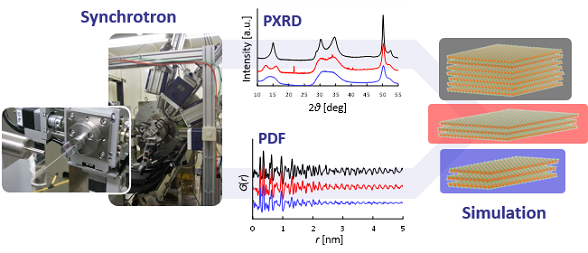 The complementary use of forward modeling via computational chemistry and backward modeling based on experimental observations is essential for understanding nanostructured functional materials, such as catalysts. Here, the total X-ray scattering technique with synchrotron radiation is employed as a means of backward modeling for quantitative determination of a catalyst nanostructure.
The complementary use of forward modeling via computational chemistry and backward modeling based on experimental observations is essential for understanding nanostructured functional materials, such as catalysts. Here, the total X-ray scattering technique with synchrotron radiation is employed as a means of backward modeling for quantitative determination of a catalyst nanostructure.Development of Concept Catalysts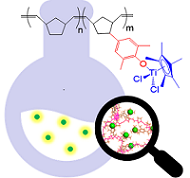
In addition to inorganic materials such as metals and metal oxides, which are typical for solid catalysts, our laboratory conducts research on polymers and nanomaterials such as graphene and metal organic frameworks. Such research on other materials as well as for other purposes gives us an inspiration of new concepts of catalysts. For example, a marriage of catalysis and polymer chemistry has resulted in a catalyst system that conceptually bridges two extreme ends of catalysts, i.e. molecular catalysts with well-defined but less functional features and solid catalysts with multifunctional but ill-defined features. Multiple active species grafted onto a single polymeric chain realize cooperative catalysis in a random coil as a well-defined nano-sized reactor. Use of graphene in photocatalysis and fine chemistry also has brought us excellent catalysts.
Literature: i) J. Catal. 2018, 357, 6; ii) ACS Catal. 2019, 9, 3648; iii) Carbon 2018, 133, 109; iv) Appl. Catal. A: Gen. 2018, 549, 60.
 A concept originated from a fusion of catalytic and polymer chemistries. By integrating molecular catalysts into precisely synthesized polymer chains, the well-defined feature of molecular catalysts and the multifunctionality of solid catalysts can be combined. Individual polymer chains exist as random coils in the reaction solution and act as nanoreactors that exhibit cooperative catalysis.
A concept originated from a fusion of catalytic and polymer chemistries. By integrating molecular catalysts into precisely synthesized polymer chains, the well-defined feature of molecular catalysts and the multifunctionality of solid catalysts can be combined. Individual polymer chains exist as random coils in the reaction solution and act as nanoreactors that exhibit cooperative catalysis.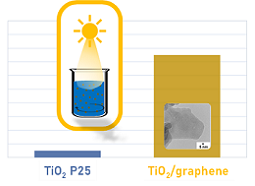 A visible-light photocatalyst that exhibits an extremely high activity for the decomposition of organic pollutants in water. It originated from our finding in another research on the chemical exfoliation of graphite: We found that metal alkoxide could be used as an exfoliating solvent. From here, we started the research and reached a nanocomposite structure in which titanium dioxide nanosheets evenly cover graphene. Currently, the research is extended to the decomposition of marine plastics.
A visible-light photocatalyst that exhibits an extremely high activity for the decomposition of organic pollutants in water. It originated from our finding in another research on the chemical exfoliation of graphite: We found that metal alkoxide could be used as an exfoliating solvent. From here, we started the research and reached a nanocomposite structure in which titanium dioxide nanosheets evenly cover graphene. Currently, the research is extended to the decomposition of marine plastics.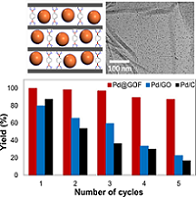 The structure of graphene oxide stacked via linker molecules is called graphene oxide framework (GOF). By using the uniform interlayer space, highly dispersed nanoparticles with uniform size can be synthesized. The resultant nanocomposite possesses a molecular sieving ability and can be used as a highly recyclable catalyst for various reactions.
The structure of graphene oxide stacked via linker molecules is called graphene oxide framework (GOF). By using the uniform interlayer space, highly dispersed nanoparticles with uniform size can be synthesized. The resultant nanocomposite possesses a molecular sieving ability and can be used as a highly recyclable catalyst for various reactions.Polymer Informatics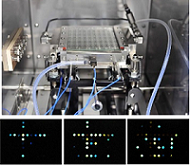
Just by counting the plastic products around us, it is obvious how we have been enjoying the benefits of plastics. In order to shift to a circular economy, we need to promote material or chemical recycling of plastic products, which requires a variety of technological innovations. Taniike laboratory addresses this urgent issue based on high-throughput experimentation and materials informatics.
Currently the most researched technology is related to additive formulations that improve the durability of polymers. In order to promote material recycling, it is essential to minimize the degradation that occurs during the processing and service. A variety of additives, including antioxidants, provide practical durability to polymers that are not tolerant of continuous stresses such as heat and light. Our laboratory has established technologies for ultra-efficient screening of additive formulations. In addition to the research on traditional synthetic plastics, we have participated in projects on future plastic materials such as recombinant spider silk and bio-based polymers, where our technologies are used to provide the durability to these novel materials.
Literature: i) Polym. Degrad. Stab. 2015, 121, 340; ii) ACS Appl. Polym. Mater. 2020, 8, 3319; iii) Polym. Degrad. Stab. 2018, 153, 37; iv) Polym. Chem. 2017, 8, 1049.
 We developed a high-throughput chemiluminescence imaging instrument that can acquire the durability of 100 polymer samples against thermo-oxidative degradation in a single measurement. In the case of photo-induced yellowing, a further efficient protocol was developed (288 samples per measurement), enabling us to obtain data equivalent to several decades in a very short period of time.
We developed a high-throughput chemiluminescence imaging instrument that can acquire the durability of 100 polymer samples against thermo-oxidative degradation in a single measurement. In the case of photo-induced yellowing, a further efficient protocol was developed (288 samples per measurement), enabling us to obtain data equivalent to several decades in a very short period of time.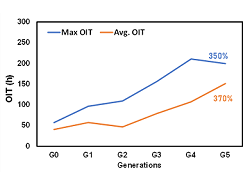 Exploration of additive formulations based on high-throughput experimentation and a genetic algorithm. It can be seen how the genetic algorithm evolved the performance of the formulations. Durability data of 5.5 years was obtained in 50 days. We found a very effective formulation that can suppress high-temperature oxidation of a commodity plastic for more than 200 hours.
Exploration of additive formulations based on high-throughput experimentation and a genetic algorithm. It can be seen how the genetic algorithm evolved the performance of the formulations. Durability data of 5.5 years was obtained in 50 days. We found a very effective formulation that can suppress high-temperature oxidation of a commodity plastic for more than 200 hours.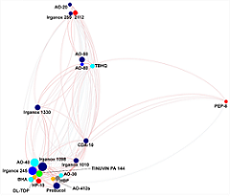 Visualization of the interaction among additives. It shows that synergistic combinations of additives are critical for the design of formulations.
Visualization of the interaction among additives. It shows that synergistic combinations of additives are critical for the design of formulations.Polymer Nanocomposites
Polymer nanocomposites are hybrid materials in which nanosized particles are dispersed in a polymer matrix. The general aim of the polymer nanocomposites is to add the functions of nanoparticles to a polymer while maintaining the original advantages of the polymer, such as processability and low density. If the material is properly designed, the addition of a few percent of nanoparticles could induce physical properties that are completely different from those of the original polymer. In order to achieve this, it is essential to develop various technologies, e.g. for uniformly dispersing nanoparticles with different chemical affinity from polymers, for strengthening the interfacial bonding between polymers and nanoparticles, and for simultaneously controlling the dispersion and distribution of nanoparticles.
Taniike laboratory designs original polymer nanocomposites by using our knowledge of catalysts and nanomaterials. For example, we have invented a reactor granule technology that enables uniform dispersion of various kinds of nanoparticles for a wide range of the loading without a third component like a compatibilizer. Using this or other technologies, various functional materials have been developed, such as UV-blocking transparent plastics, heat-dissipating plastics, polymer film capacitors, and highly permeable nanocomposite filtration membranes.
Literature: i) Compos. Sci. Technol. 2017, 144, 151; ii) Polymer 2017, 127, 251; iii) Compos. Sci. Technol. 2014, 102, 120; iv) Compos. Part B 2019, 162, 662; v) Polymer 2014, 55, 1012; vi) Colloids Surf. A Physicochem. Eng. Asp. 2021, 614, 126204; vii) 特願2014-265887.
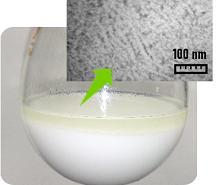 A reactor granule technology is our own technology to prepare polymer nanocomposites, which is based on the impregnation of porous polymer powders with filler precursors and their chemical conversion into highly dispersed nanoparticles during melt compounding. It is a simple and versatile solution for preparing highly functional polymer nanocomposites for various applications.
A reactor granule technology is our own technology to prepare polymer nanocomposites, which is based on the impregnation of porous polymer powders with filler precursors and their chemical conversion into highly dispersed nanoparticles during melt compounding. It is a simple and versatile solution for preparing highly functional polymer nanocomposites for various applications. A nanocomposite with highly dispersed silver nanoparticles, which exhibits glossy, antibacterial, and nonlinear optical properties.
A nanocomposite with highly dispersed silver nanoparticles, which exhibits glossy, antibacterial, and nonlinear optical properties.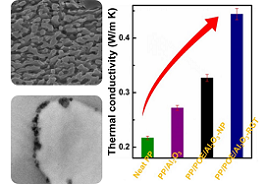 A nanocomposite in which the dispersion and distribution of aluminum oxide nanoparticles as well as the phase separation of the polymer blend are simultaneously controlled. Uniformly distributed thermal networks result in high thermal conductivity.
A nanocomposite in which the dispersion and distribution of aluminum oxide nanoparticles as well as the phase separation of the polymer blend are simultaneously controlled. Uniformly distributed thermal networks result in high thermal conductivity.Instruments and software for high-throughput research
A variety of instruments and software are equipped in our laboratory to enhance the throughput of ideally any kinds of experiments. Our research always starts from planning and designing an optimum experimental procedure in order to maximize the throughput of the research, where existing instruments are used in combination or original instruments are developed on necessity. In the following, examples of our high-throughput research as well as our instruments and software are described.
HTE Catalyst Synthesis
Catalyst research typically consists of three steps: Preparation, evaluation, and analysis. High-throughput synthesis of a large number of catalysts followed by high-throughput evaluation of their performance leads to extremely fast catalyst screening. Furthermore, the obtained catalyst big data is analyzed by data science approaches to gain knowledge about catalyst design and functions. In this way, all the steps of catalyst research can be made high-throughput. There are many different processes involved in the synthesis and evaluation of catalysts. Taniike laboratory develops technologies to make high-throughput experimentation possible for each of these processes.
In catalyst preparation, parallel or automated processes such as liquid-phase synthesis of nanoparticles, impregnation, coprecipitation, hydrothermal and solvothermal synthesis have been achieved. These can be used in combination with automated weighing, liquid handling, and various work-up apparatus. For example, by parallelly impregnating various oxide supports with various nanoparticles prepared based on parallelized liquid-phase synthesis, a library of hundreds of catalysts can be obtained in a short time.
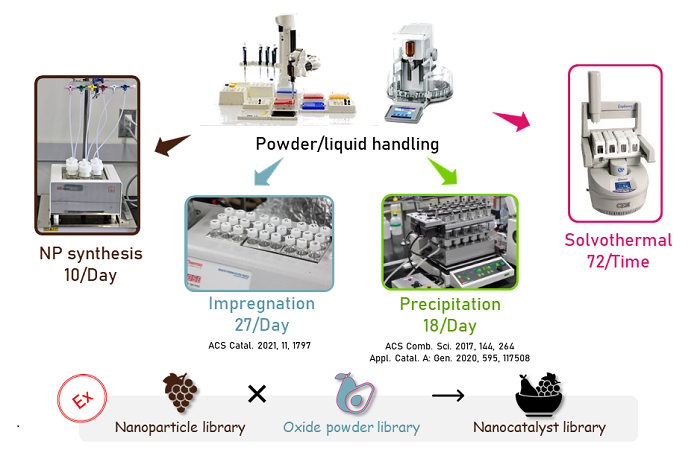
HTE Catalyst Evaluation
There are various processes (or types of reactors) for catalyst evaluation. So far, we have realized high-throughput experimentation for batch or semi-batch stirred reactions, batch photocatalytic reactions, and fixed-bed flow reactions. For example, a high-throughput catalyst evaluation system of a fixed bed flow reactor type is used to evaluate the performance of hundreds of catalysts in various reaction conditions. This leads to catalyst big data consisting of tens thousands of data points in a short period of time. The data is then analyzed using various machine learning methods to extract knowledge on catalyst design and catalysis itself.
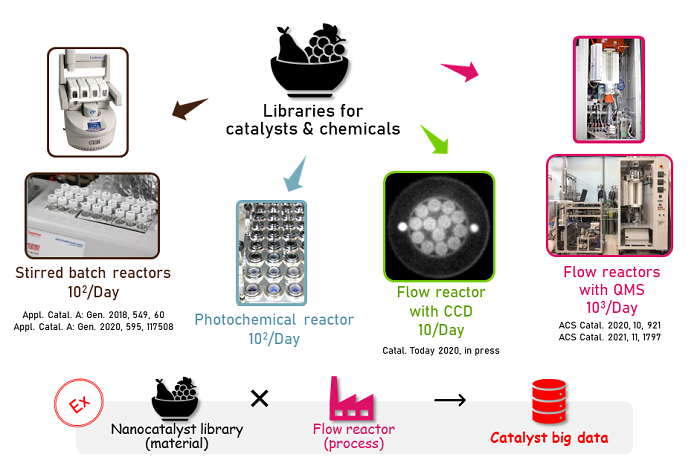
HTE Polymer
Not only in obvious cases such as fiber-reinforced plastics and rubber-toughened plastics, polymers are mostly used by blending them with different polymers, fillers, and/or additives in order to realize various properties and functions for individual applications. The number of combinations is enormous even for a single polymer, i.e. high-throughput experimentation is an ideal technique for polymer compounding research. However, this has minimally been realized in reality. The fundamental difficulty is that the physical properties of the same formulation widely differ, depending on the compounding process.
Our laboratory has gradually improved the throughput of experiments for the polymer compounding research (albeit far from satisfactory). So far, compounding additives using parallelized solution casting, compounding fillers using a micro compounder, and measurements of various properties (durability, mechanical properties, thermal conductivity, dielectric properties, transparency, and so on) have been made feasible.
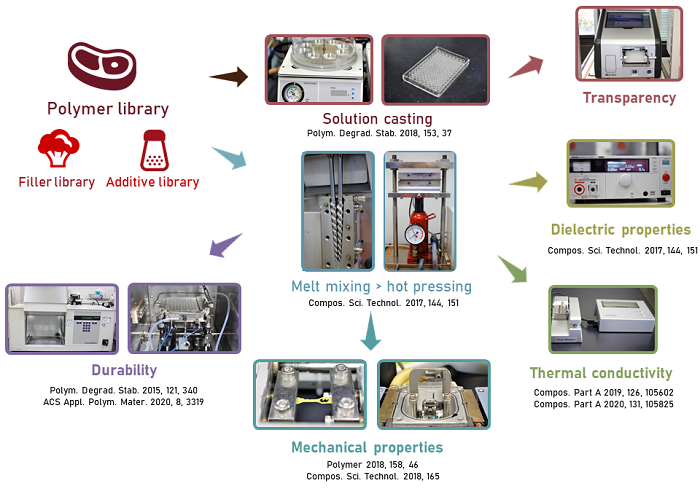
Typical instruments and software
 Precision balance (Mettler Toledo Quantos QD205DR)
Precision balance (Mettler Toledo Quantos QD205DR)Precision balance for automatic dispensing of liquids and powders. It is useful when performing a lot of powder weighing.
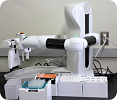 Pipetting robot (Andrew+)
Pipetting robot (Andrew+)Large-scale combinatorial explorations often require pipetting hundreds of times a day. This robot can completely automate the task.
 Multipurpose parallel reactor (modified from Büchi Synchore Q-101)
Multipurpose parallel reactor (modified from Büchi Synchore Q-101)A parallel reactor customized based on a commercial one to conduct a wide variety of experiments. For 24 glass tubes of 50 mL, heating, refluxing, mechanical or vortex stirring, gas replacement, evaporation, vacuum drying, and addition or extraction by syringes can be implemented.
 Microwave synthesizer with a robotic arm (CEM Discover SP with Explorer 72)
Microwave synthesizer with a robotic arm (CEM Discover SP with Explorer 72)A commercial microwave reactor equipped with a robotic arm. For example, 72 microwave-assisted reactions can be run in a sequential manner, where the temperature, pressure, and microwave irradiation can be independently programmed.
 Parallel hot stirrer (Thermo Scientific Reacti-Therm TS-18823)
Parallel hot stirrer (Thermo Scientific Reacti-Therm TS-18823)Commercially available hot stirrer. For example, 27 reactions (10 mL vials) can be performed in parallel. It is suitable for simple batch reactions, but with proper cap design, more complicated reactions are also tractable.
 Centrifugal evaporator (EYELA CVE-3110)
Centrifugal evaporator (EYELA CVE-3110)It is used for vacuum drying catalyst powder directly from a slurry state. Very useful when a large number of samples need to be dried.
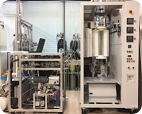 Catalyst screening instrument (developed in-house)
Catalyst screening instrument (developed in-house)High-throughput catalyst evaluation system of a fixed bed flow reactor type. Cooperation of a gas generator, an electric furnace, an autosampler, and a mass spectrometer enables the acquisition of the performance of 20 catalysts under a series of programmed reaction conditions in a fully automated manner. We have two systems, and the second one is designed for reactions of volatile liquids. This is a flagship instrument of our laboratory, providing thousands of data points per day.
 Photocatalyst screening instrument (developed in-house)
Photocatalyst screening instrument (developed in-house)Prototype photocatalytic screening system, where 4700 white LED chips enables uniform irradiation over a large area of 500 mm x 500 mm at a power of 550 W/m2. Jacketed multi-stirrer cells allow 132 batch photoreactions to be run in parallel.
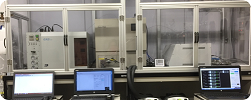 Operando chemiluminescence analyzer (developed in-house)
Operando chemiluminescence analyzer (developed in-house)This system can detect catalytic reactions through chemiluminescence at high speed (1 sec) and high sensitivity (10-100 nmol) as well as in an operando manner. Reaction imaging is also possible by replacing the photomultiplier with a CCD camera.
 Parallel film casting apparatus (EYELA custom-made)
Parallel film casting apparatus (EYELA custom-made)A custom-made system for film casting. A total of 32 polymer cast films can be made at once in four chambers with controlled temperature and vacuum.
 Twin-screw micro compounder (Xplore MC5)
Twin-screw micro compounder (Xplore MC5)Capable of performing melt compounding of polymer at a minimum scale of 3.5 mL. It dramatically reduces the amount of a sample required, which greatly improves the throughput of the sample synthesis.
 Chemiluminescence imaging instrument (developed in-house)
Chemiluminescence imaging instrument (developed in-house)In recent years, attention has been focused on the long-term durability of polymer, which is essential to realize recycling and reuse. This high-throughput system can simultaneously measure the high-temperature durability of 100 samples of polymer through imaging the chemiluminescence associated with oxidation. This is another flagship instrument of our laboratory, which can complete measurements that would take several years in one to two months.
 Parallel pressure filtration device (developed in-house)
Parallel pressure filtration device (developed in-house)Home-made device for reverse osmosis filtration at high pressure. It is made of a transparent pressure-resistant plastic, making it lightweight and suitable for parallelization. It is used in screening of thin film nanocomposite membranes for desalination.
 In-situ mid/far-IR spectrometer (JASCO FT/IR-6600 with Harrick Dewar DER-3-XXX)
In-situ mid/far-IR spectrometer (JASCO FT/IR-6600 with Harrick Dewar DER-3-XXX)An instrument for in-situ mid/far-IR spectroscopy with controlled temperature and atmosphere. Used for characterization of catalyst surfaces.
 Microplate reader (BioTek Epoch 2)
Microplate reader (BioTek Epoch 2)A microplate reader. For example, we use it to study yellowing of transparent plastics which are cast on a 96-well multi-plate.
 Gas chromatograph with an autosampler (Agilent 7890A)
Gas chromatograph with an autosampler (Agilent 7890A)This gas chromatograph system equips an autosampler and low thermal mass modules, being useful for product analysis in high-throughput catalyst screening.
 Chemicals library (LMS Harmony R.M)
Chemicals library (LMS Harmony R.M)Software for managing the chemical library of our laboratory. It allows individual users to search chemicals that they want to use from their own PC.
 Materials Studio (BIOVIA, shared)
Materials Studio (BIOVIA, shared)Versatile software which equips a variety of simulation and analytical modules. For example, we use it for quantum chemical simulation, quantitative structure-activity relationship, statistical analysis, and so on.
 LabEquipedia (developed in-house)
LabEquipedia (developed in-house)This is a home-made platform for managing and sharing manuals, instructions, and troubleshooting guides for equipment, software, experimentation, etc.
 PyCharm (JetBrains)
PyCharm (JetBrains)An integrated development environment (IDE) for Python. Used for a variety of data visualization and machine learning.
Lists of instruments and software
Weighing
Precision balance (Mettler Toledo Quantos QD205DR)
Pipetting robot (Andrew+)
Chemical synthesis
Multipurpose parallel reactor (modified from Büchi Synchore Q-101)
Microwave synthesizer with a robotic arm (CEM Discover SP with Explorer 72)
Parallel hot stirrer (Thermo Scientific Reacti-Therm TS-18823)
Workup
Desktop high-speed centrifuge (AS ONE AS185H)
Centrifugal evaporator (EYELA CVE-3110)
Electric furnace (FULL-TECH FT-001W)
Freeze drier (Labconco FZ2.5)
Catalyst evaluation
Catalyst screening instrument (developed in-house)
Photocatalyst screening instrument (developed in-house)
Operando chemiluminescence analyzer (developed in-house)
Chemiluminescence imaging instrument (developed in-house)
Polymer processing
Parallel film casting apparatus (EYELA custom-made)
Twin-screw micro compounder (Xplore MC5)
Two-roll mixer (Imoto IMC-1104)
Hot press (AS ONE AH-2003)
Polymer properties and testing
EMS viscometer (Kyoto Electronics EMS-1000)
Polarized optical microscope (Olympus BH-2)
Tensile tester (Abecks Dat-100)
Dynamic mechanical analyzer (TA Instruments Q800-RH)
Chemiluminescence analyzer (Tohoku Electronic Industrial CLA-FS4)
Chemiluminescence imaging instrument (developed in-house)
Sun tester (Toyoseiki CPS plus)
Weatherometer (Atlas SUNTEST XXL+)
Thermal wave analyzer (Hitachi High-Tech Science ai-Phase mobile 1u/2)
LCR meter (Hioki IM3533-01)
Insulation resistance tester (Kikusui Electronics TOS5301)
Parallel pressure filtration device (developed in-house)
Atomic Force Microscope (Park NX10)
General characterization
In-situ mid/far-IR spectrometer (JASCO FT/IR-6600 with Harrick Dewar DER-3-XXX)
Laser Raman spectrometer (JASCO NRS-4100)
Microplate reader (BioTek Epoch 2)
X-ray diffractometer with an autosampler (Rigaku MiniFlex600)
X-Ray fluorescence spectrometer with an autosampler (PANalytical Epsilon 3)
Thermal gravimetric analyzer (Rigaku Thermo plus EVO2)
Gas chromatograph with an autosampler (Agilent 7890A)
Automated contact angle meter (Excimer SImage AUTO 100)
Gas chromatograph (Agilent 8860 GC)
Particle size analyzer (Microtrac MT3300EX II)
Hyperspectral microscope (HinaLea 4200M)
Software (selected)
Chemicals library (LMS Harmony R.M)
Materials Studio (BIOVIA, shared)
SIMCA (Umetrics)
PyCharm (JetBrains)
CHEMKIN-Pro (ANSYS)
DX data management (Pleasanter)
LabEquipedia (developed in-house)
